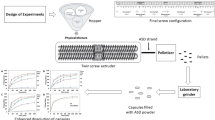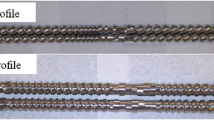Abstract
The present study aimed to increase the in vitro dissolution rate of lacidipine, a poorly water-soluble drug, by formulating amorphous solid dispersions (ASDs) using hot-melt extrusion (HME). Differential scanning calorimetry, powder X-ray diffraction, polarized light microscopy, and Fourier transform infrared were used to characterize the optimal formulations and evaluate the physical stability for the stress test. Film-casting method and hot-stage microscopy were applied to study the miscibility of lacidipine and the drug carriers. In vitro dissolution tests were conducted as the final evaluation index. The optimal formulations were successfully obtained with Soluplus and PVP VA64 at a drug/carrier ratio of 1:10 (w/w), Fourier transform infrared studies revealed the hydrogen bonding between drug and polymers, and in vitro dissolution rates of the optimal formulations were extremely enhanced compared to bulk lacidipine and physical mixtures, similar with that of the commercial tablet. The ASD formulated with Soluplus showed better physical stability than that with PVP VA64. A strong hydrogen bonding and good drug-polymer miscibility were essential to hinder the recrystallization of lacidipine ASDs. In conclusion, the lacidipine ASD formulated with Soluplus showed a significant increase in in vitro dissolution rate and favorable physical stability in the stress test.








Similar content being viewed by others
References
Khadka P, Ro J, Kim H, Kim I, Kim JT, Kim H, et al. Pharmaceutical particle technologies: an approach to improve drug solubility, dissolution and bioavailability. Asian Journal of Pharmaceutical Sciences. 2014;9(6):304–16.
Fu Q, Li B, Zhang D, Fang M, Shao J, Guo M, et al. Comparative studies of the in vitro dissolution and in vivo pharmacokinetics for different formulation strategies (solid dispersion, micronization, and nanocrystals) for poorly water-soluble drugs: a case study for lacidipine. Colloids & Surfaces B Biointerfaces. 2015;132:171–6.
Han X, Ghoroi C, To D, Chen Y, Davé R. Simultaneous micronization and surface modification for improvement of flow and dissolution of drug particles. Int J Pharm. 2011;415(1–2):185–95.
Ewing AV, Wray PS, Clarke GS, Kazarian SG. Evaluating drug delivery with salt formation: drug disproportionation studied in situ by ATR-FTIR imaging and Raman mapping. Journal of Pharmaceutical & Biomedical Analysis. 2015;111:248–56.
Choi JS, Kwon SH, Lee SE, Jang WS, Byeon JC, Jeong HM, et al. Use of acidifier and solubilizer in tadalafil solid dispersion to enhance the in vitro dissolution and oral bioavailability in rats. Int J Pharm. 2017;526(1–2):77–87.
Semjonov K, Kogermann K, Laidmäe I, Antikainen O, Strachan CJ, Ehlers H, et al. The formation and physical stability of two-phase solid dispersion systems of indomethacin in supercooled molten mixtures with different matrix formers. Eur J Pharm Sci. 2017;97:237–46.
Donovan MJ, Saleem I, Smyth HDC. Pharmaceutical applications of hot-melt extrusion: part II. Ichnos An International Journal for Plant & Animal Traces. 2008;14(3):215–7.
Baronsky-Probst J, Möltgen CV, Kessler W, Kessler RW. Process design and control of a twin screw hot melt extrusion for continuous pharmaceutical tamper-resistant tablet production. European Journal of Pharmaceutical Sciences Official Journal of the European Federation for Pharmaceutical Sciences. 2016;87:14–21.
Feng J, Xu L, Gao R, Luo Y, Tang X. Evaluation of polymer carriers with regard to the bioavailability enhancement of bifendate solid dispersions prepared by hot-melt extrusion. Drug Dev Ind Pharm. 2012;38(6):735–43.
Tho I, Liepold BJ, Maegerlein M, Brandl M, Fricker G. Formation of nano/micro-dispersions with improved dissolution properties upon dispersion of ritonavir melt extrudate in aqueous media. Eur J Pharm Sci. 2010;40(1):25–32.
Crowley MM, Zhang F, Repka MA, Thumma S, Upadhye SB, Battu SK, et al. Pharmaceutical applications of hot-melt extrusion: part I. Drug Dev Ind Pharm. 2007;33(10):909–26.
Maniruzzaman M, Nokhodchi A. Continuous manufacturing via hot-melt extrusion and scale up: regulatory matters. Drug Discov Today. 2016;22(2):340–51.
Cheng HY, Friis A. Modelling extrudate expansion in a twin-screw food extrusion cooking process through dimensional analysis methodology. Food Bioprod Process. 2010;88(2–3):188–94.
Leuner C, Dressman J. Improving drug solubility for oral delivery using solid dispersions. European Journal of Pharmaceutics & Biopharmaceutics Official Journal of Arbeitsgemeinschaft Fur Pharmazeutische Verfahrenstechnik E V. 2000;50(1):47.
Bruce LD, Shah NH, Malick AW, Infeld MH, Mcginity JW. Properties of hot-melt extruded tablet formulations for the colonic delivery of 5-aminosalicylic acid. European Journal of Pharmaceutics & Biopharmaceutics Official Journal of Arbeitsgemeinschaft Fur Pharmazeutische Verfahrenstechnik E V. 2005;59(1):85–97.
Maniruzzaman M, Morgan DJ, Mendham AP, Pang J, Snowden MJ, Douroumis D. Drug–polymer intermolecular interactions in hot-melt extruded solid dispersions. Int J Pharm. 2013;443(1–2):199–208.
Vasconcelos T, Sarmento B, Costa P. Solid dispersion as strategy to improve oral bioavailability of poof water soluble drugs. Drug Discov Today. 2008;12(23–24):1068–75.
Djuris J, Nikolakakis I, Ibric S, Djuric Z, Kachrimanis K. Preparation of carbamazepine–Soluplus®; solid dispersions by hot-melt extrusion, and prediction of drug–polymer miscibility by thermodynamic model fitting. Eur J Pharm Biopharm. 2013;84(1):228.
Meng F, Dave V, Chauhan H. Qualitative and quantitative methods to determine miscibility in amorphous drug–polymer systems. European Journal of Pharmaceutical Sciences Official Journal of the European Federation for Pharmaceutical Sciences. 2015;77:106–11.
Taylor LS, Zografi G. Spectroscopic characterization of interactions between PVP and indomethacin in amorphous molecular dispersions. Pharm Res. 1997;14(12):1691–8.
Huang J, Wigent RJ, Schwartz JB. Drug-polymer interaction and its significance on the physical stability of nifedipine amorphous dispersion in microparticles of an ammonio methacrylate copolymer and ethylcellulose binary blend. J Pharm Sci. 2008;97(1):251–62.
Ochi M, Kimura K, Kanda A, Kawachi T, Matsuda A, Yuminoki K, et al. Physicochemical and pharmacokinetic characterization of amorphous solid dispersion of meloxicam with enhanced dissolution property and storage stability. AAPS PharmSciTech. 2016;17(4):932–9.
Lee CR, Bryson HM. Lacidipine. A review of its pharmacodynamic and pharmacokinetic properties and therapeutic potential in the treatment of hypertension. Drugs. 1994;48(2):274–96.
Mukharya A, Chaudhary S, Mansuri N, Misra AK. Solid-state characterization of lacidipine/PVP K29/32 solid dispersion primed by solvent co-evaporation. International Journal of Pharmaceutical Investigation. 2012;2(2):90.
Elkasabgy NA, Elsayed I, Elshafeey AH. Design of lipotomes as a novel dual functioning nanocarrier for bioavailability enhancement of lacidipine: in - vitro and in - vivo characterization. Int J Pharm. 2014;472(1–2):369–79.
Gannu R, Palem CR, Yamsani VV, Yamsani SK, Yamsani MR. Enhanced bioavailability of lacidipine via microemulsion based transdermal gels: formulation optimization, ex vivo and in vivo characterization. Int J Pharm. 2010;388(2):231–41.
Kassem MA, Elmeshad AN, Fares AR. Enhanced solubility and dissolution rate of lacidipine nanosuspension: formulation via antisolvent sonoprecipitation technique and optimization using Box-Behnken design. AAPS PharmSciTech. 2016;18(4):1–14.
Sun M, Wu C, Qiang F, Di D, Xiao K, Chao W, et al. Solvent-shift strategy to identify suitable polymers to inhibit humidity-induced solid-state crystallization of lacidipine amorphous solid dispersions. Int J Pharm. 2016;503(1–2):238–46.
Forster A, Hempenstall J, Tucker I, Rades T. Selection of excipients for melt extrusion with two poorly water-soluble drugs by solubility parameter calculation and thermal analysis. Int J Pharm. 2001;226(1–2):147–61.
Albadarin AB, Potter CB, Davis MT, Iqbal J, Korde S, Pagire S, et al. Development of stability-enhanced ternary solid dispersions via combinations of HPMCP and Soluplus® processed by hot melt extrusion. Int J Pharm. 2017;532(1):603–11.
Bikiaris D, Papageorgiou GZ, Stergiou A, Pavlidou E, Karavas E, Kanaze F, et al. Physicochemical studies on solid dispersions of poorly water-soluble drugs: evaluation of capabilities and limitations of thermal analysis techniques. Thermochim Acta. 2005;439(1–2):58–67.
Parikh T, Gupta SS, Meena AK, Vitez I, Mahajan N, Serajuddin ATM. Application of film-casting technique to investigate drug–polymer miscibility in solid dispersion and hot-melt extrudate. J Pharm Sci. 2015;104(7):2142–52.
Weuts I, Van Dycke F, Voorspoels J, De Cort S, Stokbroekx S, Leemans R, et al. Physicochemical properties of the amorphous drug, cast films, and spray dried powders to predict formulation probability of success for solid dispersions: etravirine. J Pharm Sci. 2011;100(1):260–74.
Shi NQ, Zhang Y, Li Y, Lai HW, Xiao X, Feng B, et al. Self-micellizing solid dispersions enhance the properties and therapeutic potential of fenofibrate: advantages, profiles and mechanisms. Int J Pharm. 2017;528(1–2):563–77.
Funding
This work was financially supported by the National Nature Science Foundation of China (No. 81502993), by the Nature Science Foundation of Liaoning Province (No. 201700287), by the Basic Research Projects of Universities of Liaoning Provincial Department of Education (2017LQN02), and by the Career Development Program for Young Teachers in Shenyang Pharmaceutical University.
Author information
Authors and Affiliations
Corresponding author
Electronic Supplementary Material
ESM 1
(DOCX 2844 kb)
Rights and permissions
About this article
Cite this article
Xi, L., Song, H., Wang, Y. et al. Lacidipine Amorphous Solid Dispersion Based on Hot Melt Extrusion: Good Miscibility, Enhanced Dissolution, and Favorable Stability. AAPS PharmSciTech 19, 3076–3084 (2018). https://doi.org/10.1208/s12249-018-1134-9
Received:
Accepted:
Published:
Issue Date:
DOI: https://doi.org/10.1208/s12249-018-1134-9




